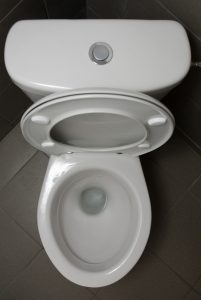 We know an overflowing toilet is one of the more alarming events that can occur with home plumbing, right up there with a burst pipe. However, there are steps to take to stop the flow and have it corrected. If you do some planning ahead to prepare for an event like this—and it can happen to any toilet, no matter its age or how well it’s cared for—you can prevent serious water damage and dangers from an overflow of sewage.
We know an overflowing toilet is one of the more alarming events that can occur with home plumbing, right up there with a burst pipe. However, there are steps to take to stop the flow and have it corrected. If you do some planning ahead to prepare for an event like this—and it can happen to any toilet, no matter its age or how well it’s cared for—you can prevent serious water damage and dangers from an overflow of sewage.
Remember, helpful professional plumbers are on-call to assist you with bathroom plumbing in Burlington, VT and throughout Northwest Vermont and Northeast New York.
First, Shut Off the Flow of Water
The first step to take when you have an overflowing toilet is to stop the flow of water. In most cases, this is easy … as long as you know where to look.
Freshwater flows to the tank of the toilet through a feed line, which is a plastic piece of tubing coming out of the wall and connecting to the underside of the tank. There should be a handle near where the feed line comes from the wall. Simply turn that, and it will shut off the water flow. And we recommend you go turn the toilet valve on and off a few times after you read this to make sure it isn’t stuck. These valves are rarely used, and that can be a problem when it comes time to actually use one.
“But I Don’t See a Handle!”
This is why it’s good to make checks and plan ahead of time. If there’s no visible handle, that means the bathroom was originally constructed with the valve hidden behind the wall or tiles. We recommend you contact our plumbers to make some bathroom plumbing modifications so you can access the valve—it’s vital to be able to shut off water flow yourself.
If you have an overflowing toilet and no access to shutting off the feed valve, you’ll have to take a different approach. Take off the lid of the tank (be careful with it; it’s an expensive piece to replace if it breaks!) and pull up the tank float until the water stops. You may need something to keep it propped up, like a ruler.
Soak Up the Water
Water damage is one of the major problems with an overflowing toilet, so you want as much of it removed as possible. Take a bunch of towels and lay them around the base of the toilet to soak up the water before it can seep down into the flooring.
See if You Can Clear the Clog
A clog may be the reason for the overflow. Make sure you have a toilet plunger near at hand, and use it to try to clear the clog. Don’t make sharp jabs with it; apply steady pressure with each push.
Call for a Professional Plumber
If you can’t clear the clog, you’ll need a licensed plumber to help out. And even if you can clear the obstruction, we recommend you have a plumber look over the toilet to see if it’s suffering from age or other troubles. For older toilets, the best solution is to replace it. This isn’t just a good idea to prevent further overflows. It will help you save water. (Older toilets can use up to 6 gallons per flush, while new low-flow models only use 1.28 gallons per flush.)
Look to Red Rock Mechanical, LLC for all your plumbing needs in Burlington, VT and the Plattsburgh, NY area.







